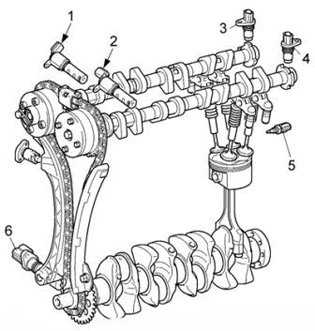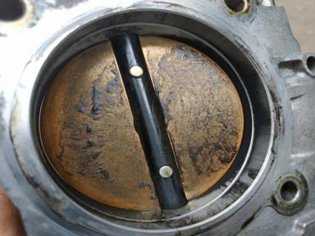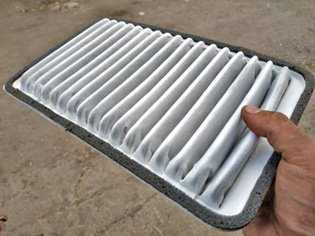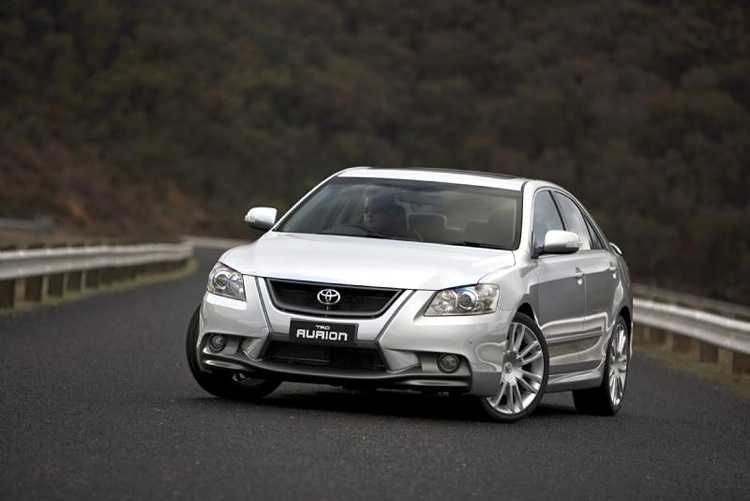2GR-FE: Known Problems
In the past, many Toyota engines were known for excessive oil consumption, such as the 2AZ-FE engine. Piston rings and valve stems are the most common cause of this issue. Unfortunately, it’s a pretty expensive repair, so keep an eye out for this issue if you’re ever buying a car with the 2GR!
Luckily, the oil burning issue doesn’t affect the 2GR-FE as badly as other Toyota engines.
After some research, the idler pulley was the only real problem we could find that was consistent across multiple 2GR engines.
When this pulley starts to go bad, it can cause belt squeak or load rattling noises. Toyota has a heavy-duty version of this component available, and many owners upgrade to that part to fix the issue.
Upgrades and tuning in the 2GR-FE supercharger
There is so much more to the 2GR-FE supercharger that can unleash the more power of it. There have been many upgrades done to this engine that make it a highly reliable engine. However, while trying to make it more powerful in stock form, it is slightly expensive but one can buy uprated pistons as well as camshafts plus breathing mods like a complete-exhaust system as well as cold air intakes.
Talking about the tuning, it can go around 320-330hp because of the upgrades and depending on its power output of it. However, one can also opt for supercharger kits. Both TRD, as well as HKS, are known to have developed kits for the 2GR engines which can allow getting an excess of 350hp.
What is Toyota 2GR-FE Engine?
This motor from Toyota is a part of the GR series of machines. It is there to replace the previous machines of Toyota. The JZ Inline-6, MZ V6, and VZ V6 are replaced. It comes with noticeable characteristics that span its entire family.
The 2GR-FE engine is an open-deck piston V6 powered by gasoline. It features aluminum DOHC cylinder heads and die-cast aluminum blocks at 60° in its specs.
It was made by Toyota in 2004, to follow the previous release of 1GR-FE in 2002. This 2GR engine comes with a feature of transverse mounting. Compared to its predecessor, it is lighter in terms of its weight.
That boosts the popularity of this version away from the 1GR. There are about 18 cars of Toyota in total that use this engine. They are mostly trucks and SUVs. Engine-swapped MR2s, a few Lotus cars, and a Bolwell Nagari 300 are also using it.

1GR
1GR-FE
Toyota FJ Cruiser
1GR-FE — это 4.0 Версия L (3956 куб. См), предназначенная для продольной установки в пикапах с задним и полным приводом. Он имеет отверстие и ход 94 мм × 95 мм (3,70 × 3,74 дюйма). Выходная мощность составляет 236 л.с. (176 кВт; 239 л.с.) при 5200 об / мин с 266 фунт-фут (361 Н · м) крутящего момента при 4000 об / мин с октановым числом 87 и 240 л.с. (179 кВт; 243 л.с.) при 5200 об / мин при 278 фунтов Ft (377 Нм) при 3700 оборотах в минуту с октановым числом 91. Этот двигатель оснащен системой Toyota VVT-i, изменения фаз газораспределения на впускном кулачке и степенью сжатия 10,0: 1. Рабочий вес, включая жидкости, составляет 166 кг (366 фунтов).
Обновленная версия этого двигателя оснащена Dual VVT-i, увеличивая мощность до 270 л.с. (201 кВт; 274 л.с.) при 5600 об / мин и 278 фунт-фут (377 Нм). при 4400 об / мин с октановым числом 87. Внутри 1GR используется конструкция камеры сгорания «конусно-сдавленная » с соответствующими поршнями для улучшения защиты от детонации и улучшения характеристик двигателя, а также повышения эффективности впуска и расхода топлива. Toyota приняла впускной канал сиамского типа, который уменьшает площадь поверхности стенок порта и предотвращает прилипание топлива к ним. Этот двигатель имеет специальные чугунные гильзы цилиндра, залитые в блок, которые являются шипами для улучшения сцепления между гильзой и блоком цилиндров. В случае повреждения стенки цилиндра (задиров, глубоких выступов и т. Д.) Необходимо заменить весь блок цилиндров. Для увеличения жесткости блока 1GR также получает термостойкий пластиковый изолятор / протектор, который заполняет пустое пространство между внешней частью цилиндров и блокирует материал, общий для двигателей с открытой палубой. Для повышения эффективности охлаждения в 1GR используются водяные каналы между отверстиями двигателя. Таких проходов на каждый берег по два, всего четыре. Это уменьшает образование горячих пятен в цилиндре и поддерживает более равномерную температуру в камере сгорания.
Комплект нагнетателя был доступен на Tacoma и FJ Cruiser, но был снят с производства Toyota.
Новая Toyota HiLux 2015 года получает немного другую версию одинарного двигателя VVT-i, с единственным изменением, которое заключается в удалении воздухозаборного бачка и замене его корпусом обычного воздушного фильтра на впускную трубу для разгона танковый стиль. Новая впускная труба теперь содержит резонаторы. Выходная мощность не изменилась.
Варианты 1GR-FE первого поколения с одним VVT-i оснащены системой индукции акустического контроля Toyota . Эта система состоит из перегородки, разделяющей впускной коллектор на две части, и регулирующего клапана всасываемого воздуха (в перегородке) для регулирования его эффективной длины. Когда двигатель работает на умеренных оборотах и под высокой нагрузкой, исполнительный механизм закрывает регулирующий клапан всасываемого воздуха, чтобы увеличить эффективную длину впускного коллектора. При других условиях эксплуатации регулирующий клапан всасываемого воздуха открывается, чтобы уменьшить эффективную длину впускного коллектора.
Применения с VVT-i (календарные годы):
- 2002-2009 Toyota 4Runner / Hilux Surf (GRN210 / 215)
- 2007-2011 Toyota Land Cruiser (GRJ200)
- 2002 -2009 Toyota Land Cruiser Prado (GRJ120 / 121/125)
- 2004–2015 Toyota Tacoma (GRN225 / 245/250/265/270)
- 2005-2015 Toyota Hilux (GGN10 / 20)
- 2005-2006 Toyota Tundra (GSK30)
- 2006-2009 Toyota Tundra (GSK50 / 51)
- 2005–2015 гг. Toyota Fortuner (GGN50 / 60)
- 2006-2009 гг. Toyota FJ Cruiser (GSJ10 / 15)
- 2009-настоящее время Toyota Land Cruiser 70
- 2015 – настоящее время Toyota Hilux
Приложения с Dual VVT-i (календарь лет):
- 2009 – настоящее время Toyota 4Runner (GRN280 / 285)
- 2009–2017 Toyota FJ Cruiser
- 2011–2014 Toyota Tundra (GSK50/51)
- 2012 – настоящее время Toyota Land Cruiser
- 2012 – настоящее время Lexus GX 400 (GRJ150)
- 2015 – настоящее время Toyota Fortuner
- 2009 – настоящее время Toyota Land Cruiser Prado (GRJ150 / 150R / 155)
Photography credits
Drifted would like to extend thanks to the following sources for the use of their images:
- Wheelsage
- CarThrottle
- I Heart Japanese Cars
- Toyota Tumblin’
- Swindon
- Paultan
Written by Joe Terrell
Joe is an avid writer and car enthusiast. When he’s not cruising the streets alongside his friends in his Nissan Silvia S15, he’s drifting on his VR racing simulator.
Joe’s passion for cars is always on display. With a keen eye for detail and a deep understanding of the automotive industry, he hopes his writing conveys his excitement and knowledge of cars and games.
Joe’s work has been featured on many platforms including drivetribe.com, smartdrivinggames.com, carthrottle.com, databox.com and ceoblognation.com.
When he’s not behind the wheel or at his keyboard, he’s likely daydreaming of his ultimate ride — the legendary Lexus LFA.
Latest articles
-
Nissan’s 350z is the JDM performance car of this decade and to celebrate we have assembled all the information you will ever need to know on the mighty Z33.
-
Looking for a performance G37 exhaust? You’ve come to the right place. We compare nine of the best G37 exhausts available to help you find your perfect system.
-
We deep dive into everything you need to know about Forza Horizon 5 Houses. Learn why all the houses in Forza Horizon 5 are essential and how to unlock them.
-
We present fifteen of the best JDM cars of the nineties and check out the latest news on their upcoming state-of-the-art successors.
-
This year marks what would have been deceased action hero Paul Walker’s 50th year and to honour that we have assembled 43 of his most memorable quotes.
-
Eager to upset your rivals by getting the fastest car in Forza Horizon 4? We’ve got you covered! This guide covers the 22 fastest cars you’ll find in the game.
-
Looking to turn your Nissan 370Z into a boosted street or track weapon? Not sure about picking the right brand or products? Our 370z supercharger guide has got you covered!
-
As Playground Games takes drifting to the next level, we bring you the best drift car Forza Horizon 5 guide to find the ultimate drift car in the game.
-
Looking for the best 240SX coilovers on the market for your pride and joy? Join us in our ultimate 240SX coilover guide and explore the best kits on sale.
-
Looking to throw down your Miata at the track, carve up the canyons or find the perfect stance? We compare the best suspension kits on the market in our ultimate Miata coilover guide.
-
Are you considering purchasing a Nissan 350Z? Make sure you check out this guide before handing over your hard-earned cash.
-
We present seventeen of the best drift cars for beginners. From BMW to Toyota, we’ll find you the perfect platform to get started on your drifting adventure.
-
Mazda’s 13B engine is one of the most sensational engines ever created. In this guide, we’ll be exploring everything you need to know about the JDM legend.
-
The 2UZ-FE doesn’t get as much attention as the 1UZ-FE, leaving this hugely underrated high-torque powerplant a tempting proposition for petrolheads.
-
Depreciation becomes your new best friend when it comes to picking up a performance car bargain. We’re checking out our favorite fast cars under $20k.
-
We show you exactly how to modify your SR20 to boost power and enhance reliability in our step-by-step SR20DET tuning guide.
2GR-FXE
Just like the 2AZ-FXE, the 2GR-FEX uses an Atkinson cycle design. This works by effectively reducing the compression stroke and leaving the exhaust stroke as it was. This improves efficiency by a massive amount without introducing any unnecessary complexity.
On top of the Atkinson cycle design, this engine also uses VVT-i like the other 2GR variants and adds an EGR (Exhaust Gas Recirculation) cooler.
By cooling the EGR system, Toyota increased the compression ratio up to 13:1 without having to worry about the exhaust gases becoming excessively hot. The highest power achieved by this 2GR variant is 292 horsepower in the Lexus GS 450h.
What’s Next for Toyota’s 2GR Engine?
Since the release of the 2GR-FE, Toyota has continued to develop the awesome 2GR range through to the present day.
With the supercharged 2GR-FE most recently finding its way into the Lotus Exige Cup for their new 2018 model, it’s far from the end, even for the FE. The stock powerplant is also still being used in several production cars, such as Toyota’s Estima/Previa/Tarango range in the present day, and Lotus are still using it in the Evora.
With Toyota still using the 2GR-FSE in several production cars, such as the IS350, it looks as though they may head towards integrating the 2GR-FKS into more of their range soon.
Many of their most recent releases, such as the 2017 Toyota Camry and 2018 Lexus RC 350, have already begun using the FKS. Despite the hybrid FXS being introduced, which is based on the FKS engine, it would appear that we’re not yet going to see a true replacement for the FKS anytime soon.
Evaluation from the viewpoint of transient characteristics and liter equivalent horsepower
| Image of engine performance curve | |
|---|---|
| Changes in horsepower | 231.6PS → 280PS |
| Transition of torque | 35.3kgm → 32.4kgm |
| Liter horsepower | 81.02PS / L |
| Liter torque | 10.2kgm / L |
Harrier’s 2GR-FE V6 3456cc, compression ratio 10.8, high-octane gasoline specification naturally aspirated engine, which is the reference vehicle this time, produces a maximum output of 280 horsepower at 6200 rpm and a maximum torque of 35.3 kgm at 6200 rpm.
If you know the horsepower and the number of revolutions, you can know the torque, and if you know the torque and the number of revolutions, you can know the horsepower. The torque at 6200 rpm is 32.4kgm.
The horsepower per liter of displacement is 81.02PS / L and the torque is 10.2kgm / L. The horsepower per cylinder (single cylinder volume 576.0cc) is 46.7PS and the torque is 5.9kgm.
When the 2GR naturally aspirated engine is applied to a 10-step evaluation based on the deviation value aggregated from all NA vehicles registered on this site, the evaluation is ” quite good” with a converted horsepower of and a converted torque of . It is categorized as ” high power engine “.
Toyota 2GR-FE Technical Spec sheets
| Manufacturer | Kamigo Plant, Shimoyama Plant, Toyota Motor Manufacturing Alabama,Toyota Motor Manufacturing Kentucky |
| Production years | 2004-present |
| Cylinder block material | Aluminum |
| Cylinder head material | Aluminum |
| Fuel type | Gasoline |
| Fuel system | Sequential fuel injection;Direct injection + port injection |
| Configuration | V |
| Number of cylinders | 6 |
| Valves per cylinder | 4 |
| Valvetrain layout | DOHC |
| Bore, mm | 94.0 mm (3.7 in) |
| Stroke, mm | 83.0 mm (3.27 in) |
| Displacement, cc | 3,456 (210.8 cu in) |
| Type of internal combustion engine | Four-stroke, naturally-aspirated |
| Compression Ratio | 10.8:1 – 2GR-FE;11.8:1 – 2GR-FSE/FKS |
| Power, hp | 249-360 hp (183-265 kW)/6,000-6,600 |
| Torque, lb-ft | 234-367 lb-ft (317-498 Nm)/3,200-4,800 |
| Engine weight | 360 lbs (163 kg) |
| Firing order | 1-2-3-4-5-6 |
| Engine oil weight | 5W-30 |
| Oil change interval, mile | 6,000 (10,000 km) or 12 month |
| Engine oil capacity, liter | 6.1 |
Cars With Toyota 2GR-FE Engine
- Toyota Camry
- Toyota RAV4
- Toyota Highlander
- Toyota Tacoma
- Toyota Alphard
- Toyota Aurion
- Toyota Harrier
- Toyota Mark X
- Toyota Mark X Zio
- Toyota Sienna
- Toyota Venza
- Toyota Crown
- Toyota Estima/Previa
- Toyota Avalon
- Lexus GS 350
- Lexus GS 450h
- Lexus IS 350
- Lexus ES 350
- Lexus RX 350
- Lexus RX 450h
- Lotus Evora S/GTE
- Lotus Exige S
- Bolwell Nagari 300
You Might Also Like:
Mitsubishi 6G72 Engine (Overview, Problems, Reliability)
Toyota 2GR-FE Overview
Checking out the specifications of an engine is the first thing to do before buying and using it. In terms of the positive sides of the Toyota 2GR-FE engine, it offers magical cooling efficiency at its base level.
The dual VVT-i system addition to this engine enhances the torque and power simultaneously. Overall, the latest version of 2GR-FE is a reasonable engine to consider if you are into the world of an engine swap.
When it comes to the power outage, the 2GR-FE is affected by the vehicle specs that use it. There will be a different range of maximum horsepower depending on the car models.
The official information regarding the power output of this engine mentions a range from 295hp to 315hp. Meanwhile, the torque ranges from 248 pounds/feet to 260 pounds/feet. One thing to note, it can reach 360hp at 367 pounds/feet with the best build of the car.
This engine weighs 395 pounds, and it comes with an 83mm stroke, 94mm bore. When the 4-valves per cylinder design pairs with the DOHC system of Toyota, the efficiency increases noticeably.
The fuel system that transports gasoline from its tank is a sequential fuel injection system. It combines a direct injection system plus port injection. This V6 engine is naturally aspirated so that there will not be any iconic sound of turbo coming out of it.
How is the 2GR-FE supercharger different from 2GR-FSE?
There is no doubt about the fact that the 2GR-FE supercharger is highly impressive but it is often seen that it is compared with 2GR-FSE. With the launch of 2GR-FSE, the successor to the 2GR-FE engine, its main addition is D-4S twin injection system. Therefore, it leads to better and improved power. Such type of engines needs to have an in-engine mechanism like swirl pots so that air turbulence can be increased. However, in FSE port injection was done for a better air-fuel mixture.
Also, FSE is very heavy as compared to the 2GR-FE supercharger which is 174kg vs 163kg. Both the engines have the capability to produce around 314hp. This means that the 2GR-FE supercharger is a complete winner when it comes to power to weight ratios.
Слабые места мотора 2GR
- Система DVVT-i;
- Водяной насос (помпа);
- Катушки зажигания;
- ЦПГ;
- Радиатор системы охлаждения;
- Дроссельные заслонки;
- Пятый цилиндр (на 2GR-FSE).

Состав привода ГРМ системы DVVT-i:1 — выпускной клапан VVT; 2 — впускной клапан VVT; 3 — датчик положения распредвала (выпускных клапанов); 4 — датчик положения распредвала (впускных клапанов), 5 — температурный датчик ОЖ; 6 — датчик положения коленвала.
Система DVVT-i – имеет свой ресурс безупречной работы и после его окончания начинаются проблемы с работой мотора. DVVT-i — цепной привод ГРМ задействующий впускные и выпускные распредвалы с механизмами с VVT на обеих головках. VVT механизмы изменения фаз (муфты, они же фазорегуляторы) на впуске и выпуске отличаются по конструкции небольшими отличиями. К распредвалам муфты крепятся пятью болтами. С износом работающих в постоянном трении деталей механизмов VVT-i, несмотря на постоянные потоки моторного масла, появляются дефекты на плоскостях деталей: увеличенная шероховатость и неплоскостность, риски, борозды, ступенчатые переходы. Из-за неравномерного износа по толщине работающих в сопряжении деталей в муфтах (корпус, ротор, фиксатор, звездочка), в работе фазорегуляторов могут возникать подклинивания, что сразу же нарушает фазы газораспределения, то есть впускные и выпускные клапаны начинают открываться и закрываться некорректно. По этой же причине приходит «конец» клапану VVT-i (соленоиду) и он теряет способность постоянной работы (клинит). В дополнение, часто причиной нарушения работы системы является засорение сеточки масляного фильтра клапана VVT-i. Что происходит с мотором при проблемах в системе VVT-i вы можете прочитать ниже в недостатках.
Водяной насос (помпа) имеет ресурс 50 — 70 тыс. км. При выработке установленной наработки насос не обеспечивает герметичность охлаждающей жидкости и она подтекает. Дефект устраняют заменой узла.
Холостой ход. Обычный дефект на японских движках вызванный засором дроссельных заслонок. При периодическом обслуживании заслонок проблем с ними не возникает. У водяного насоса малый ресурс. После пробега 50-70 тыс. км требует замены.
Катушки зажигания. На ДВС раннего выпуска случаи отказов катушек случались с большей вероятностью.
ЦПГ 2GR-FSE рассчитана под высококачественные моторные масла, соответственно при применении масел с несоответствующими химмотологическим свойствам маслам рекомендованных производителем возникает повышенный износ цилиндро-поршневой группы.
Радиатор системы охлаждения в трубном пакете нередко дает течь ОЖ. Исходя из отзывов, радиатор по прочности слабоват, что-то с ним перемудрили конструкторы. Для замены подходит китайская подделка и «ходит» он дольше.
 |
 |
Дроссельные заслонки впускного коллектора загрязняются пылью из-за подсоса неочищенного воздуха из-под воздушного фильтра. При виде грязи (пыли) на заслонках, надо понимать, что пыль поступала в цилиндры и служила абразивом. Это одна из причин снижения компрессии в цилиндрах. Причина подсоса неочищенного воздуха ветхое крепление воздушного фильтра не обеспечивающее должную герметичность. Для исправления дефекта достаточно приклеить по периметру фильтрующего элемента уплотняющий материал (губку).
Пятый цилиндр на 2GR-FSE перегревается и данный дефект считается конструкционным по причине недостаточной проработки при проектировании и испытаниях. В итоге, при перегреве на гильзе цилиндра нарушается зеркало и появляются задиры. Вместе с тем, проблема сопровождается высоким расходом масла. Блок цилиндров, как уже отмечалось выше, одноразовый и ремонту не подлежит.
Toyota 2GR engine tuning
Chiptuning. N/A
The 2GR is not the best one for naturally aspirated tuning. You should buy MWR pistons fitted to 12 compression ratio with a MWR performance camshafts (duration of 256/256 deg, lift of 10.7/10.7 mm) and cold air intake. You should also do port and polish, purchase a 3-1 headers, performance exhaust system, and set the ECU.
It will help to achieve over 320 horsepower.
2GR-FE Supercharger. Turbo
HKS, TRD supercharger kits are produced for the 2GR engine. You just need to buy such a kit, bolt it on the stock internals and get about 350 horsepower. It will be safe enough. If it’s not enough, you should get new Wiseco Pistons fitted to 9 compression ratio, more powerful supercharger, 500 cc injectors and Apexi Engine Management. Then you should increase boost pressure up to maximal point.You can assemble a 2GR-FE Turbo (2GR-FTE) in a similar way, but this project will cost extremely high.
Which cars came with the 2GR FE?
Although it’s not one of the most commonly found swaps, the 2GR-FE has frequently found itself being used for a wide variety of purposes. It has become a popular choice among various generations of MR2 owners looking to modernize their power.
Given that Lotus fitted supercharged variations to their Exige S and Evora S models, it proves how well suited this can be for lighter mid-engine cars.
Some popular Japanese vehicle models that utilize this engine include the Toyota Sienna minivan, The Toyota Venza, the Toyota Harrier and The Toyota Avalon. We have included a complete list of vehicles down below.

VVT-i engine cars:
- 2002-2009 Toyota 4Runner / Hilux Surf (GRN210/215)
- 2007-2011 Toyota Land Cruiser (GRJ200)
- 2002-2009 Toyota Land Cruiser Prado (GRJ120/121/125)
- 2004-2015 Toyota Tacoma (GRN225/245/250/265/270)
- 2005-2015 Toyota Hilux (GGN10/20)
- 2005-2006 Toyota Tundra (GSK30)
- 2006-2009 Toyota Tundra (GSK50/51)
- 2005-2015 Toyota Fortuner (GGN50/60)
- 2006-2009 Toyota FJ Cruiser (GSJ10/15)
- 2015-present Toyota Hilux
Dual VVT-i engine cars:
- 2009-present Toyota 4Runner (GRN280/285)
- 2009-2017 Toyota FJ Cruiser
- 2010-present Toyota Tundra (GSK50/51)
- 2012-present Toyota Land Cruiser
- 2012-present Lexus GX 400 (GRJ150)
- 2012-2017 Toyota Aurion (GSV50)
- 2015-2017 Toyota Alphard/Vellfire (GGH30/35)
- 2006-2019 Toyota Estima/Previa/Tarago (GSR50/55)
- 2014-present Toyota Land Cruiser 70
- 2015-present Toyota Fortuner
- 2009-present Toyota Land Cruiser Prado (GRJ150/150R/155)
Cars That Came With The 2GR-FE
Like pretty much every other Toyota engine, Toyota used the 2GR in lots of different vehicles over the years. Why develop an entirely new engine when you can just adapt the current one for different models.
Lotus even used this engine in their Evora S model, which outputs 345 horsepower thanks to its supercharger.
- 2004 – present: Toyota Avalon
- 2006 – 2012: Toyota Aurion
- 2005 – 2012: Toyota RAV4
- 2006 – present: Toyota Estima
- 2006 – present: Toyota Camry
- 2006 – present: Lexus ES 350
- 2007 – 2015: Lexus RX 350
- 2007 – 2016: Toyota Highlander
- 2007 – 2012: Toyota Blade
- 2007 – 2013: Toyota Mark X Zio
- 2008 – present: Toyota Alphard
- 2008 – 2016: Toyota Venza
- 2009 – 2016: Toyota Sienna
- 2009 – present: Lotus Evora
- 2011 – present: Lotus Evora S
- 2012: Lotus Exige S
Toyota 2GR engine specs
| Manufacturer |
Kamigo Plant Shimoyama Plant Toyota Motor Manufacturing Alabama Toyota Motor Manufacturing Kentucky Toyota Motor Manufacturing West Virginia |
| Also called | Toyota 2GR |
| Production | 2005-present |
| Cylinder block alloy | Aluminum |
| Configuration | V6 |
| Valvetrain | DOHC 4 valves per cylinder |
| Piston stroke, mm (inch) | 83 (3.27) |
| Cylinder bore, mm (inch) | 94 (3.70) |
| Compression ratio | 10.8 11.8 12.5 13 |
| Displacement | 3456 cc (210.9 cu in) |
| Power output | 183 kW (249 HP) at 6,000 rpm 200 kW (270 HP) at 6,200 rpm 201 kW (272 HP) at 6,200 rpm 205 kW (278 HP) at 6,200 rpm 206 kW (280 HP) at 6,400 rpm 227 kW (309 HP) at 6,400 rpm 232 kW (315 HP) at 6,400 rpm 234 kW (318 HP) at 6,400 rpm 241 kW (328 HP) at 6,400 rpm 257 kW (350 HP) at 7,000 rpm 265 kW (360 HP) at 6,400 rpm |
| Torque output | 317 Nm (234 lb·ft) at 4,800 rpm 336 Nm (248 lb·ft) at 4,700 rpm 333 Nm (246 lb·ft) at 4,700 rpm 346 Nm (255 lb·ft) at 4,700 rpm 350 Nm (258 lb·ft) at 4,600 rpm 377 Nm (278 lb·ft) at 4,800 rpm 377 Nm (278 lb·ft) at 4,800 rpm 380 Nm (280 lb·ft) at 4,800 rpm 400 Nm (295 lb·ft) at 4,800 rpm 400 Nm (295 lb·ft) at 4,500 rpm 498 Nm (367 lb·ft) at 3,200 rpm |
| Redline | – |
| HP per liter | 72 78.1 78.7 80.4 81 89.4 91.1 92 94.9 101.3 104.2 |
| Fuel type | Gasoline |
| Weight, kg (lbs) | 163 (360) 2GR-FE |
|
Fuel consumption, L/100 km (mpg) -City-Highway-Combined |
for Lexus RX350 14.3 (16) 8.4 (28) 10.6 (22) |
| Turbocharger | Naturally aspirated |
| Oil consumption , L/1000 km (qt. per miles) |
up to 1.0 (1 qt. per 750 miles) |
| Recommended engine oil | 5W-30 |
| Engine oil capacity, L (qt.) | 6.1 (6.4) |
| Oil change interval, km (miles) | 5,000-10,000 (3,000-6,000) |
| Normal engine operating temperature, °C (F) | – |
| Engine lifespan, km (miles)-Official information-Real |
– 300,000+ (180,000) |
| Tuning, HP-Max HP-No life span loss |
350+ – |
| The engine is installed in |
Toyota AvalonToyota CamryToyota CrownToyota Estima/PreviaToyota RAV4Toyota HighlanderToyota SiennaToyota VenzaLexus GS350Lexus GS450hLexus IS350Lexus ES350Lexus RX350Lexus RX450h Toyota Alphard Toyota Aurion Toyota Harrier Toyota Mark X Toyota Mark X Zio Lotus Evora Lotus Exige S |
2GR-FE supercharger -History
In the year 2004 2GR-FE supercharger was released in the marketplace. This engine is slightly different as compared to other Toyota GR engines such as 1GR or 2GR. During this time, Toyota was opting for 3.5L displacement which is why the bore of 1GR-FE is 94mm and the stroke is decreased to 83mm.
However, similar to 1GR-FE, the 2GR-FE supercharger has an open-deck aluminum alloy block in a cylindrical shape as well as spiny-type cast-iron liners. Inside the engine, there is a forged steel crankshaft along with 5 counterweights as well as connecting rods.
Also, the Toyota 2GR-FE is 3kgs light as compared to 1GR and has a service weight of 163kg. Moreover, there are various superchargers specially created for the 2GR-FE supercharger and Lotus used the 2GR-FE supercharger in its Evora S as well as Exige S. Plus, Bolwell is still using this engine in its Nagari 300 models.

















![Toyota 2gr-fe engine problems: is the engine reliable? [fix]](http://hyundai-partner.ru/wp-content/uploads/c/8/1/c8128f2aac3d2bad15b85b446cd52078.jpeg)











